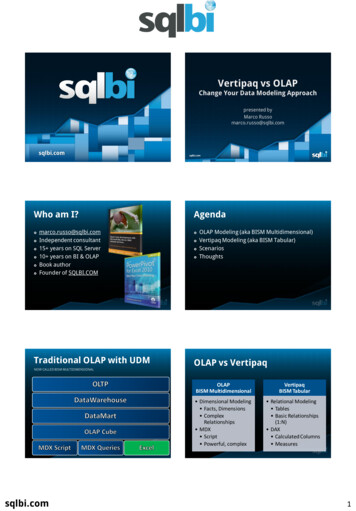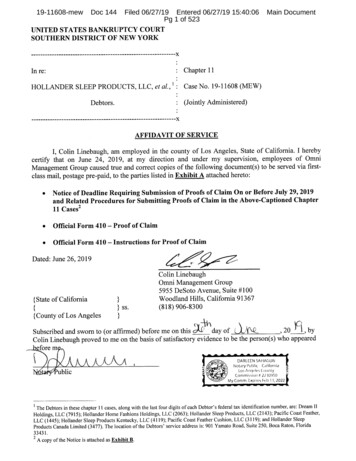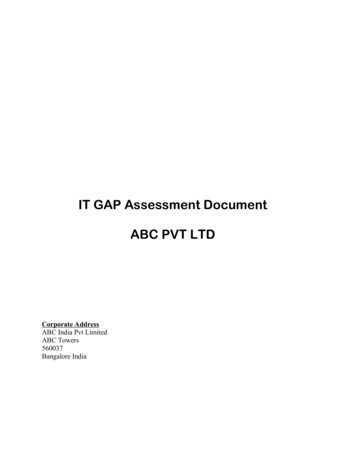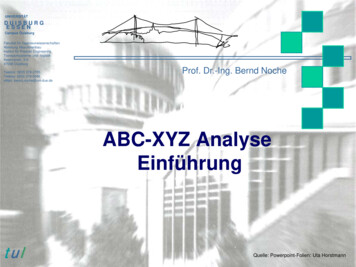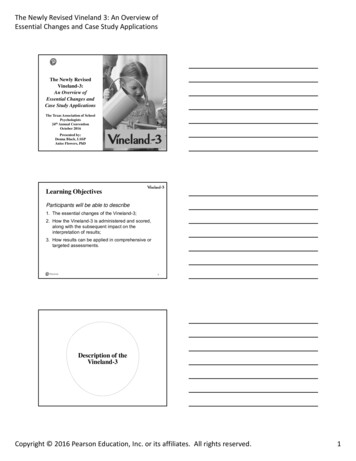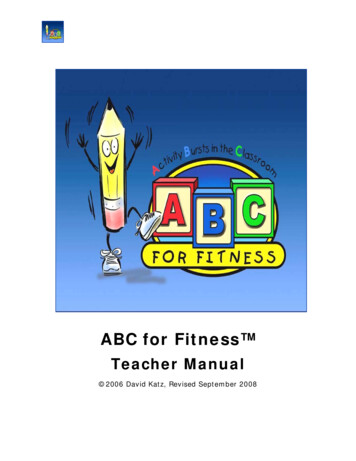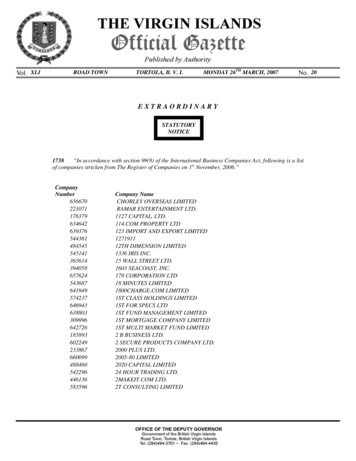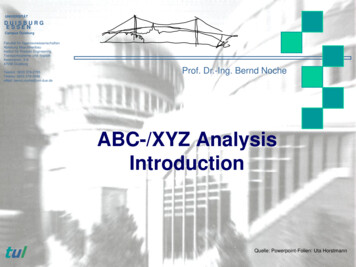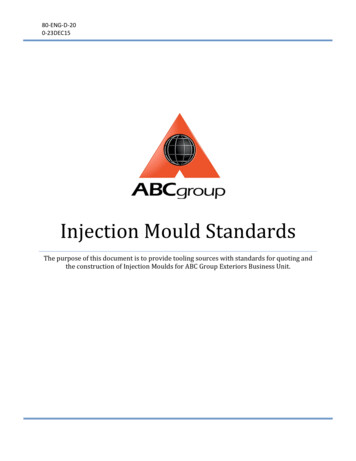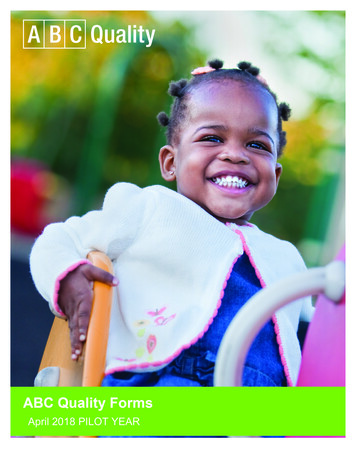
Transcription
SECTION 3: ABC Quality FormsApril 2018 PILOT YEAR
Table of ContentsSECTION 3: ABC Quality Forms . 1Level C ABC Quality Participation Agreement Form. 3Eligibility Checklist and Submission Form . 7Code of Ethics Form . 8Element II: Staff Education and Professional Development Tracking Form . 9Element V Process Quality Self-Assessment Form – ABC Quality’s Intentional Teaching Tool (ITT) –Infant and Toddler Classrooms . 10Element V Process Quality Self-Assessment Form – ABC Quality’s Intentional Teaching Tool (ITT) –Preschool Classrooms . 14Element V Process Quality Self-Assessment Form – ABC Quality’s Intentional Teaching Tool (ITT) –School Age Classrooms . 19
Level C ABC Quality Participation Agreement FormNEW RENEWALSouth Carolina Department of Social ServicesABC Quality Rating & Improvement SystemQuality Compliance AgreementAS A CONDITION OF PARTICIPATION AND PAYMENT, I UNDERSTAND AND AGREE: Enrollment in the South Carolina Department of Social Services ABC Quality Rating & ImprovementSystem (ABC Quality) is voluntary. This Agreement shall not be assigned or transferred.ØØIt is only valid at the address enrolled. Should the provider move or relocate, this agreementbecomes null and void.The provider shall immediately notify ABC Quality of any changes in ownership of the program orfacility including, any management agreements. A change in ownership will render thisAgreement null and void, and payment will cease for any current children being served with SCVoucher. All information provided on the Provider Enrollment Form and the Rate Certification Form is incorporatedas a part of this Agreement, and the provider certifies that all information is true to the best of itsknowledge. This Agreement shall be in effect for a period of beginning . ABCQuality can initiate termination of this agreement by delivering written notification to the provider. Thenatural ending of this Agreement is not appealable. It is not a guarantee or a right that ABC Quality willoffer the provider another Agreement. The provisions of this Agreement and performance hereunder are subject to all applicable laws,regulations, ordinances, and codes of the federal, state, and local governments. All terms of theAgreement shall be construed in a manner consistent with the aforesaid laws, regulations, ordinances,and codes. Should any of the terms or conditions of this agreement conflict with any of the aforesaidlaws, regulations, ordinances, or codes, then only those terms shall be deemed inoperative and null andvoid to the extent of the conflict and shall be deemed modified to conform therewith; the remainder ofthe agreement shall be unaffected. The provider will comply with Public Law 103-327, Part C, Environmental Tobacco Smoke Act, also knownas the Pro-Children Act, which prohibits smoking in any indoor facility used routinely or regularly for theprovision of health, day care, education, or library services to children under the age of 18 years. If any dispute shall arise under the terms of this Agreement, the sole and exclusive remedy shall be thefiling of a Notice of Appeal within 30 calendar days of receipt of written notice of the ABC Quality actionor decision which forms the basis of the appeal. Administrative appeals shall be in accordance with theDSS regulations R. 126-150, et seq., Code of Laws of South Carolina (1976, as amended), Volume 27, andin accordance with the Administrative Procedures Act, Section 1-23-380, code of Laws of South Carolina(1976, as amended). No new SC Voucher children will be allowed to connect to my facility during an appeal with ABC Quality orDSS Child Care Licensing. However, the program may continue serving current children for the duration oftheir eligibility period unless the health and safety of the children are jeopardized.
South Carolina Regulations For Child Care Facilities The facility must maintain a current SC Department of Social Services (DSS) license/approval orDepartment of Defense Certificate, at all times, if required, by State or Federal law or regulations, andmeet all applicable state and local health and safety requirements in order to provide services under thisAgreement. The facility must maintain a history of compliance with regulations. History of compliance is defined ahaving: No frequent or multiple deficiencies or a significant event posing substantial threat to the healthor safety of the children that involves supervision, compliance with ratios, or health and safety violations. All staff supervising/caring for children must have Cardiopulmonary Resuscitation (CPR) certification andpediatric first aid certification. All staff supervising/caring for children must meet the health and safety preservice requirement within 90days of hire. If the health and safety of children are jeopardized and depending upon the severity of the circumstances,ABC Quality may initiate termination of the program’s enrollment and immediately withdraw childrenreceiving SC Voucher from the program, even if the program is pursuing an appeal with Child CareLicensing.Service Costs, Payment and Client Fees The actual rate charged for children under this Agreement, including the Registration Fee, shall notexceed the actual rates charged to all other children except when there are different actual rates chargedfor different ages within care types. When there are different actual rates charged for different ageswithin care types, SC Voucher will pay according to the SC Voucher Maximum Payment Scheduled. Any available discounts will be extended to children covered under this Agreement to the same extentand in the same manner as all other children. If the actual rates charged to private paying clients exceed the maximum rate paid by SC Voucher, theprovider may collect the difference from the client, in addition to the client fee. The client fees established by SC Voucher shall be collected from each client whose child is covered underthis Agreement in advance of service unit delivery. SC Voucher assumes no responsibility for collection orpayment of client fees including any additional assessed client fees charged by the provider. Requested changes in the service costs shall be submitted to SC Voucher sixty (60) days prior to theeffective date of the increase. SC Voucher has the sole and exclusive right to accept or reject any changein the service rate. All services provided and claims submitted shall be in accordance with 45 CFR 98 (1998), ProviderBusiness Procedures issued by ABC Quality, and all applicable federal and state laws, rules, andregulations. Claims for payment shall be honored by SC Voucher only for active eligible clients as verified by the childcare provider and authorized by SC Voucher. SC Voucher may not honor payment requests for services submitted by the provider which are more thansixty (60) calendar days later than the service ending dates. SC Voucher shall not be liable for payment ofvouchers submitted by the provider that exceed this time frame.
Child Care Records The following records shall be maintained for each child receiving SC Voucher from the time of enrollmentuntil the facility has been monitored and the records reviewed, or for a period of three years, whichever isthe longest:o Daily attendance - maintained in support of payment vouchers; ando Copies of Service Voucher Logs [SVL]. The provider shall report service units not provided and absences as they occur. Failure to report both ofthese may result in recoupment of funds. The provider shall notify SC Voucher when a child misses ten (10) consecutive days without a waiver. If the provider continues to serve a client beyond the allowable number of absences for the child, SCVoucher may recoup funds from the provider. Records and/or reports requested by ABC Quality shall be furnished upon request. During normal business hours, ABC Quality and/or their designee shall have access to all records requiredunder this Agreement. They shall have the right to: examine and make copies, excerpts or transcriptsfrom all records unless precluded by federal or state law; contact and conduct private interviews with theprovider and/or its employees; and conduct on-site reviews of all matters relating to this Agreement. Once the provider accepts a child using SC Voucher, the provider shall not terminate the child’sattendance without prior notification to SC Voucher. Such notification must include the reason forrequested termination, such as failure to pay any client fees, and must be properly documented.Discontinuation of Service to Clients The provider shall be notified if SC Voucher terminates a client. The provider shall be reimbursed only forservice units provided to the child until the effective termination date given by SC Voucher. The providermust report any service units not provided and absences to SC Voucher. Clients will be allowed to finish any week that payment has been requested for on the SVL.Discipline Corporal punishment is strictly prohibited for any children in the facility, regardless of whether they arechildren using SC Voucher, private paying children, or children of the owner or employees. Corporalpunishment is the use of physical force to the body as a discipline measure. Physical force to the bodyincludes, but is not limited to spanking, slapping, biting, and shaking. The provider agrees to have awritten policy that corporal punishment is not allowed, that is signed by parents and staff, and that isupdated yearly.General Issues The provider shall safeguard the use and disclosure of information concerning applicants for or recipientsof services in accordance with all applicable federal and state laws and regulations and shall restrictaccess to, and use and disclosure of, such information in compliance with said laws and regulations. ABC Quality will notify the appropriate Child Care Licensing Region of all findings of non-compliance toLicensing Regulations. ABC Quality assumes no responsibility with respect to accidents, illnesses, or claims arising out of anywork undertaken with the assistance of funds paid under this Agreement. The provider shall take
necessary steps to ensure or protect itself, its clients, and its personnel. The provider agrees to complywith all applicable local, state, and federal acts, rules, and regulations. The provider must comply with Title VI of the Civil Rights Act of 1964 and Section 504 of the RehabilitationAct of 1973 when center-based and group home care is provided. If the provider receives eighty percent (80%) or more of its operating budget from state and federal funds,it shall not discriminate as to religion in the admission of any child nor in the employment of personnel. The provider will serve any children enrolled through this Agreement only at the facility and addressenrolled. The provider will notify ABC Quality of any intentions to relocate its facility prior to the move. Theprovider shall not serve any children under this Agreement at the new location/facility until it has metregulatory requirements and been enrolled by ABC Quality. The provider will maintain a working LAN (Local Area Network) telephone at its facility at all times and willnotify ABC Quality of any change in phone number. Cell phones may be used only in addition to the LANline. The provider will adhere to the requirements of the ABC Quality Standards. If the provider receives a grant, it agrees to remain enrolled in ABC Quality for the period required by thegrant or funds may be recouped. If the provider’s enrollment agreement is terminated by ABC Quality or any age group is de-enrolled, theprovider cannot reapply for enrollment in ABC Quality for a minimum of one calendar year from the dateof termination or de-enrollment.I certify that I have read, understand and agree to all terms and conditions of this Agreement and theenrollment information I have furnished is true, accurate and complete. I also certify that I have the authorityto enter into this agreement and am responsible for adhering to all duties, and responsibilities set forth in theagreement.Child Care Provider:(Signature of Owner or Authorized Agent of Owner)Date:Printed Name of Owner or Authorized Agent of Owner:Name of Facility/Provider:Federal ID/Social Security Number:
Eligibility Checklist and Submission FormPlease verify the following and prepare evidence of met criteriaName of Owner Completing Form:Date Document Completed:CriteriaMetOwner SignatureCurrent, regular license/approval/registration (or exemption) with evidence ofhistory of compliance with SC licensing regulations. History of compliance isdefined as having no frequent or multiple deficiencies or a significant eventposing a substantial threat to the health or safety of the children that involvessupervision, compliance with ratios, or health and safety violations and/ orHead Start and other early care and education programs operated by military ortribal programs must show substantial compliance with their regulatory agency.Current Pediatric First Aid and Infant/Child CPR certification for all staffresponsible for caring for or supervising children.Discipline policy prohibiting corporal punishment signed and dated by all staffannually.Completion of the SC Health and Safety Pre-Service Certificate or ECD 101 by allstaff upon enrollment and within 90 days of hire for new staff.Signed acknowledgement from all staff confirming their knowledge of andadherence to the ABC Quality Code of Ethics (see ABC Quality Forms).Additional eligibility requirements for License-Exempt ProvidersVerification of minimum staff education/qualifications (18 years old, high schooldiploma or GED, and 6 months’ experience or supervision by a teacher withmore than 1 year experience).Health Documentation: TB test/Health Assessments for all staff (DSS Form2926) ral Registry check of all staff to be conducted by the department todetermine any abuse or neglect perpetrated by the person upon a child, and asearch of the National Crime Information Center’s National Sex OffenderRegistry and the sex offender registry act pursuant to 45 CFR Sec. 98.43 (DSSForm 2924) 24-APR-16.pdf.* Note: On or before September 2018, all staff members working at a license-exempt provider must submit to abackground check pursuant to the requirements in the 2014 Child Care and Development Block Grant Law andsupporting regulations. SC has yet to implement this procedure. License-exempt providers should be prepared tocomply once the requirement becomes effective. The background check shall include an FBI fingerprint check and asearch of databases in the state where the staff member resides and each state where the staff member residedduring the previous five years to include 1) state fingerprint check; 2) state sex offender registry; and 3) state abuseand neglect registry checks.
Code of Ethics FormCode of EthicsABC Quality is committed to a code of ethics that guides the performance, conduct, and behavior of itsparticipants including child care facilities, owners, directors, and teachers. This code offers guidance forresponsible behavior and will ensure the highest level of professionalism in the operation and activitiesof ABC Quality providers. ABC Quality participants will adhere to this code of ethics and relevant programstandards and will be held accountable for their actions.1. Participants will not harm children and will not participate in practices that are emotionally orphysically harmful, disrespectful, degrading, dangerous, exploitive, or intimidating to children.2. Participants will respect colleagues in early child care and education and support them inmaintaining the ABC Quality Code of Ethics.3. Participants will promote safe and healthy working conditions and policies that foster respect,cooperation, collaboration, competence, well-being, confidentiality, and self-esteem in staffmembers.4. Participants will not participate in practices that are in violation of laws and regulationsprotecting children in child care programs.5. Participants will demonstrate respect and professional courtesy in their relationships with otherABC Quality participants and the public.6. Participants will not discriminate against children or families on the basis of sex, race, nationalorigin, religious beliefs, medical condition, disability, or the marital status/family structure,sexual orientation or religious beliefs of their families.Adapted from NAEYC Code of Ethical Conduct, 2011I have read, understand and agree to abide to the Code of EthicsNameDate
Element II: Staff Education and Professional Development Tracking FormStaff NameProgramLeadershipor TeacherEducationAchievedTier LevelPDPEntry,(Yes/No)Skilled, orAccomplished1.2.3.4.5.6.7.8.9.10.AnnualTraining Hours(# of certified)Date StaffEvaluationcompleted
Element V Process Quality Self-Assessment Form – ABC Quality’s Intentional Teaching Tool(ITT) – Infant and Toddler ClassroomsStandard V.A. Responsive and Sensitive CareIndicatorV.A.1 Demonstrates physical warmth through touching,holding, hugging, patting, rocking, and/or keeping a childclose to the teacher’s body.V.A.2 Contributes to the overall positive tone of theclassroom by being respectful and calm.V.A.3 Spends the majority of time interacting withchildren.V.A.4 Responds immediately and appropriately tosupport a child’s expression of emotions.V.A.5 Recognizes children’s need for attachment bydemonstrating patience and understanding.V.A.6 Respects children’s privacy and maintainsconfidentiality.V.A.7 Positions body to interact and engage withchildren on their eye-level.V.A.8 Respectfully and actively listens when a child talksor attempts to communicate.Met / Not YetNotesStandard V.B. Language and CommunicationIndicatorV.B.1 Regularly initiates communication with individualchildren.V.B.2 Responds verbally to all types of a child’scommunication attempts.V.B.3 Models back and forth communication withindividual children. This includes both verbal and nonverbal exchanges.V.B.4 Helps children connect words with actions byusing self-talk.V.B.5 Helps children connect words with actions byusing parallel talk.V.B.6 Encourages and supports individual children incommunicating and labeling their feelings.V.B.7 Asks individual children simple, open-endedquestions and waits for a response.V.B.8 Expands children’s vocabulary by elaborating,extending, and sharing information.V.B.9 Uses verbal play to help children learn thefoundations of language and early literacy.V.B.10 Facilitates peer-to-peer communication topromote social interaction.V.B.11 Encourages children to communicate and sharelanguage with each other.Met/Not YetNotes
Standard V.C. GuidanceIndicatorV.C.1 Uses positive guidance techniques.V.C.2 Guides children’s behavior by telling them whatto do when an undesirable or disruptive behavioroccurs.V.C.3 Demonstrates consistency with all children.V.C.4 Models and promotes positive peer interactions.V.C.5 Encourages children by acknowledging efforts,accomplishments and helpful behaviors.V.C.6 Demonstrates realistic expectations for eachchild.V.C.7 Designs and manages the classroomenvironment to promote positive interactions.V.C.8 Anticipates children’s actions to preventpotential conflict or danger by intervening whenappropriate.Met/Not YetNotesMet/Not YetNotesStandard V.D. Program StructureIndicatorV.D.1 The room meets the ABC ratios.V.D.2 The room meets the ABC group size.V.D.3 On a daily basis, children remain in their enrolledclassroom for the majority of the day.V.D.4 Children’s exposure to unfamiliar teachers islimited.V.D.5 Each child is assigned a primary teacher.V.D.6 The daily routine includes hand washing withsoap and water for teachers and children.V.D.7 Teachers use daily routines and/or transitions asopportunities to engage children.V.D.8 Teachers conduct smooth transitions.V.D.9 Accommodations are made during daily routinesto meet children’s individualized needs.V.D.10 Family-style dining is practiced during a mealservice to encourage independence and socialization.V.D.11 Teachers follow a predictable dailyroutine/schedule so children can learn sequences ofevents and feel more secure.V.D.12 Child-directed activities are provided forchildren based on their interest.V.D.13 All children must have daily outdoor time,weather permitting.
Standard V.E. Early LearningIndicatorV.E.1 Teacher provides developmentally appropriateopportunities for discovery and learning by allowingchildren to actively explore the room in a leastrestrictive environment.V.E.2 Teacher provides developmentally and culturallyappropriate opportunities for children to complete orparticipate in self-care and community care tasks.V.E.3 Teacher provides developmentally appropriateactivities and materials that are concrete andmeaningful to children.V.E.4 Teacher scaffolds children’s learning duringroutines and activities.V.E.5 Classroom has a written plan of activities thatsupports the developmental progress of children.V.E.6 Ongoing observation and documentation ofchildren’s learning and development are conductedthroughout the year.V.E.7 Planned activities are linked to specific learninggoals and objectives based on individual childassessments.V.E.8 Teacher provides experiences that promotechildren’s early literacy development.V.E.9 Teacher provides developmentally appropriateopportunities for children to develop problem solvingskills.V.E.10 Teacher uses everyday conversations asopportunities for children to learn about nature,science or math.V.E.11 Teacher provides developmentally appropriateopportunities for children to enhance fine and grossmotor development.Met/Not YetNotes
Standard V.F. EnvironmentIndicatorV.F.1 Room has sufficient, age-appropriate materialsso that all children can be actively involved.V.F.2 Children are provided some variety of materialsfrom which to choose.V.F.3 Children are provided a wide variety of materialsfrom which to choose.V.F.4 Play materials are well-organized for children toaccess them and make deliberate choices.V.F.5 The room is divided into spaces for routines andboth active and quiet play that are appropriate for theages of the children enrolled.V.F.6 Materials that reflect the diversity of thechildren’s community are accessible.V.F.7 A literacy-rich environment is present in theclassroom.V.F.8 The classroom has a variety of child-relateddisplays that are easily visible to children.V.F.9 Furnishings and equipment are child-sized andappropriate for the children currently enrolled.V.F.10 Space and furnishings are arranged so thatadults can directly supervise and respond to childrenduring routine care and play activities.V.F.11 A protected cozy area is available to childrenthroughout the day.V.F.12 The classroom space is uncluttered and noise iskept to a moderate level to avoid over-stimulation anddistraction.V.F.13 Designated outdoor spaces for infants, toddlers,and twos promote exploration in a least restrictiveenvironment.V.F.14 Outdoor equipment and materials are ageappropriate, accessible, and sufficient for all childrento be actively engaged.V.F.15 A variety of age appropriate outdoor portableplay materials/equipment is available.V.F.16 Outdoor space is planned as a play and learningenvironment.V.F.17 The outdoor environment is naturalized.Met/Not YetNotes
Element V Process Quality Self-Assessment Form – ABC Quality’s Intentional Teaching Tool (ITT) – PreschoolClassroomsStandard V.A. Responsive and Sensitive CareIndicatorV.A.1 Speaks unsolicited to a child.V.A.2 Responds verbally to child’scomments/questions.V.A.3 Acknowledges a child’s comment/request.V.A.4 Shows patience and lack of annoyance withchild’s questions.V.A.5 Converses mostly with children/limitedconversation with adults.V.A.6 Maintains eye contact while talking withchildren.V.A. 7 Gives appropriate feedback. Examples: repeatwhat child says, ask for additional information, giverelevant comments to children’s questions/comments.V.A.8 Attends while child is speaking to adult, i.e. doesnot walk away or try to do something else (like wipingtables).V.A.9 Actively listens to child’s verbalizations (does notinterrupt or cut off child’s verbalizations).Met/Not YetNotesMet/Not YetNotesStandard V.B. Language and CommunicationIndicatorV.B.1 Asks children individually to talk about activitiesthey are doing (share experiences). Examples: "Was ithard to do?" or "What are you cooking?"V.B.2 Asks children individually to share theirideas/feelings about activities/happenings. Examples:(ideas) "What will you make/build?" (feelings) "Howdo you feel about that?"V.B.3 Asks individual children open-ended questionsthat encourage critical thinking and begin with "why?what? where? and how?"V.B.4 Engages in information sharing conversations.Example: "This is a lop-ear rabbit. He likes to eatcarrots. Watch while I feed him the carrot."V.B.5 Responds in calm manner (no screaming oryelling).V.B.6 Listens to a child's explanation/comments eventhough the child's thinking is faulty. Listensrespectfully to child.
Standard V.C. GuidanceIndicatorV.C.1 Provides opportunities for children to beresponsible.Examples: picking up toys, wiping spills, personalgrooming (toileting, washing hands), obtaining andcaring for materials, and other self-help skills.V.C.2 Provides children varieties of activities fromwhich to choose: Lets children choose theinterest/activity area in which they want to work andalso choose the activity in the interest area. Thismeans that staff will not tell children where to go,what to do, or how long to work in an area.V.C.3 Staff encourages children to treat each otherwith kindness and respect; no evidence of ridicule ormaking fun of others.V.C.4 Children's mistakes are handled as routinematters.Example: "You spilled the milk, I'll help you clean it up.V.C.5 Room and materials are ready when childrenarrive.V.C.6 Children are told and prepared for what happensnext.Example: "After lunch we will take a nap."V.C.7 When a child makes an inappropriate choice, theadult helps the child to think about and make a betterchoice.V.C.8 Staff talks about the behavior she wants tocorrect instead of judging the child.Examples: "It's O.K., we all spill. Use the rag to wipeup the spill." Do not judge: "O.K., Clumsy Sam, wipeup the spill."Children are told what to do not what not to do.Instead of "Don't run" say "John, walk in the class, runoutside."V.C.9 Staff has a few, fair, simple appropriateclassroom rules (no more than 5) and states themclearly to children.Examples are: 1) Walk in the room/run outside. 2) Useyour hands to help your friends. 3) Use indoor voicesin the classroom.V.C.10 Staff practices/models classroom rules (actionsspeak louder than words).Examples: When staff asks children to use indoorvoices, she models using indoor voice (quiet, lowpitched).V.C.11 Staff encourages children and tells them whenthey have behaved appropriately.Examples: "You put the puzzle back on the shelf,thank you."V.C.12 Children's mistakes are handled individually andprivately as possible. Staff do not compare children.V.C.13 Uses positive guidance techniques.Met/Not YetNotes
Clarification: To receive credit, one positive strategymust be observed. If one instance of negativediscipline is observed, credit is not received. Examples:Redirection, Anticipation/elimination of potentialproblem, children are given choices.Standard V.D. Program StructureIndicatorV.D.1 Program maintains required ratio. Staffingpatterns shall provide for adult supervision of childrenat all times and the availability of an additional adult toassume responsibility if one adult must respond to anemergency. Staff are with children, not distracted byother duties (such as cleaning or cooking). Everyattempt shall be made to have continuity of adults whowork with children. Staff-child ratios shall bemaintained through provision of substitutes whenregular staff members are absent. Clarification: Formixed age grouping, ratio is based on youngestmember of group.V.D.2 Program maintains required group size. Staffingpatterns shall provide for adult supervision of childrenat all times and the availability of an additional adult toassume responsibility if one adult must respond to anemergency.V.D.3 Children are not required to sit at tables for longperiods of time. (Not over 15 to 20 minutes.)V.D.4 Group times are relatively short, includeexperiences children enjoy doing together, and focuson topics of current interest.Clarification: Teacher planned physical activities lasting5-10 minutes occur at least 2 times per day. These canbe planned during total group activities and mayinclude music/movement activities. If group time notobserved, teacher interview and lesson plan can bereviewed for planned activities.V.D.5 Teachers and children routinely wash hands withsoap and water at appropriate times. Clarification:Teachers and children should wash hands with soapand water before preparing/eating a meal or snack,after toileting and after contacting bodily fluids orcontaminated items.V.D.6 Morning and afternoon schedules allow a largeblock of
notify ABC Quality of any change in phone number. Cell phones may be used only in addition to the LAN line. The provider will adhere to the requirements of the ABC Quality Standards. If the provider receives a grant, it agrees to remain enrolled in ABC Quality for t
